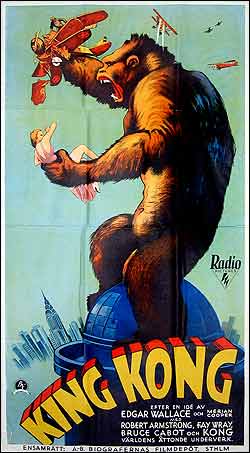SOME PEOPLE LEAD such eventful lives that we think, “They ought to make a biopic about that guy.” Hollywood pioneer Merian C. Cooper (1893–1973) led such a life, and he made such a film. Only it wasn’t a biopic—it was called King Kong. That 1933 wonder has been spiffed up, larded with extras, and packaged into the King Kong Collection (Warner Home Video, $39.92), which also contains the lesser sequel, Son of Kong (rushed into theaters the same year, and it shows), and the thoroughly enjoyable Mighty Joe Young (1949), a light-spirited romp through show business using a smaller gorilla as the MacGuffin. You can buy them all separately, along with the 1935 disaster flick The Last Days of Pompeii (Warner, $19.97). All these titles were produced by Cooper and either directed or co-directed by his longtime partner, Ernest B. Schoedsack.
Cooper’s own gravelly Southern voice can be heard on the various extras to this set, particularly on the fine new documentary I’m King Kong (on the very generous second disc of extras of the basic two-DVD Kong set). “Ah have a fourth-rate intelligence,” he drawls (almost always with a pipe clenched in his teeth). Mentioning his slight size and the shame of having washed out of military school as a teenager, he adds, “So I’m inclined to compensate for that.” Hence the giant gorilla, although it’s the director-adventurer character of Carl Denham (played by Robert Armstrong) that’s really Cooper’s surrogate: optimistic, boundlessly energetic, and living according to Cooper’s own credo, “Difficult, distant, and dangerous.”
So was his actual life. He was shot down twice and reported dead as a World War I aviator. He and Schoedsack risked their lives in the mountains of Iran to make the 1925 silent Grass (Milestone, $29.99), a jaw-dropping adventure travel film about the migratory path of nomads and their tens of thousands head of livestock (a heroic Western without cowboys or horses). On I’m King Kong, he remembers telling Schoedsack as they crossed a 14,000-foot pass, “We’ll probably die up here, but let’s make the goddamn picture!” They did, although Schoedsack separately recalls a shot he regrets not being able to film—the bloody footprints left in the white snow by the barefoot herdsmen.
NO WONDER THAT Cooper later helped champion three-strip Technicolor after World War II, when he returned to active service, serving with maverick Gen. Claire Chennault of the famous Flying Tigers squadron in China. His life during war and peace is adequately if breathlessly described in Mark Cotta Vaz’s new biography, Living Dangerously: The Adventures of Merian C. Cooper, Creator of King Kong (Villard, $24.95). Like the I’m King Kong doc, it relates how Cooper became an associate of John Ford, helping to produce Stagecoach and The Quiet Man. And, mindful of our local landmark theater, Cooper also helped develop and champion the Cinerama format. Again, the man had outsize ambitions.
However, neither the documentary nor the book—both made with the assistance of Cooper’s estate and heirs—gives enough scrutiny to Cooper’s politics, which were archconservative (well to the right of Ford’s). In addition to lionizing the egomaniacal Chennault, Cooper also supported Douglas MacArthur, whose brand of borderline right-wing fascism shows the worrisome dark side of Cooper’s can-do American spirit. His love for exotic locations, travels, and safaris also carries with it the whiff of the colonial. While he clearly loves and respects the herders of Grass (there’s mention of their Aryan heritage, but this is a decade before Hitler), the darker-skinned natives of King Kong and Mighty Joe Young don’t come off so well.
Still, the movies hold up wonderfully. At age 85, stop-motion master Ray Harryhausen, who cut his teeth on Mighty Joe Young working under Willis O’Brien (creator of the first Kong), is wonderfully lucid on his many commentaries and DVD featurettes in the Kong Collection. Part of what makes the original Kong so affecting is that the big ape is so evidently handmade; you can see the finger marks on his fur, as O’Brien and his assistants moved the puppet limbs by millimeters between each frame of film. Later, in Mighty Joe Young, the technique is much smoother (no more ruffled fur), and the monkey action is combined much better with the actors (it won an Oscar for the optical effects). Effects connoisseur Peter Jackson also appears to comment in the included DVD doc RKO Production 601: The Making of King Kong. And for gamers, sold separately, there’s Peter Jackson’s King Kong ($39.99 for PlayStation 2, Xbox, Xbox 360, and most other platforms).
It’s all a credit to Cooper, who, with Schoedsack in the plane, finally knocks Kong off the Empire State Building. And here’s another tribute. Though I was initially surprised by the casting, Peter Jackson’s choice to portray the hyperactively minded Carl Denham in his remake (see review) now makes perfect sense: Jack Black.








